by Winding Pathways | Apr 6, 2023 | Birds, Nature
Yellow-bellied sapsuckers are precise timers. Every late March we look for this gorgeous, yet sometimes hard-to-spot, migrating bird. They visit our woods in April on their way to northern breeding areas.
Weather Conditions
Late March and April nights are often below freezing, followed by warm days. That temperature fluctuation stimulates maples to send sap upward. At the same time, the warmer days awaken hungry insects seeking sweet meals. Yellow-bellied Sapsuckers arrive from the south at sap time and make their familiar wells, or small rows of holes, through maple bark. Sap oozes out and attracts protein-rich insects. Hungry migrating sapsuckers dine on both sweet sap and tasty insects.
Yellow-bellied Sapsuckers are Precise Timers
Yellow-bellied Sapsuckers time their migration precisely. They arrive exactly when conditions are perfect. Within a few weeks the weather warms, maples stop bleeding sap, insects disperse, and the birds are north of us getting ready to nest.
-
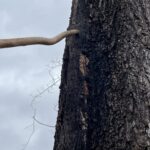
-
Insects are attracted to the sap weeping from maple trees.
-
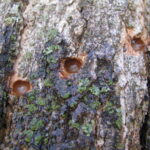
-
sapsuckers time their arrival well.
by Winding Pathways | Mar 16, 2023 | (Sub)Urban Homesteading, Birds, Nature
Tree Sparrows. Two species. What could be more confusing? Well, there’s more. Both look like common House Sparrows (formerly known as English Sparrows.
Meet the American Tree Sparrows
Marion glanced at our feeders recently and noticed what looked like a Chipping Sparrow in the midst of a flock of House Sparrows. But it wasn’t. It was an AMERICAN TREE SPARROW. This bird nests in far northern Canada and is almost always spotted in winter. Why it doesn’t keep flying south and winter somewhere warmer than Iowa is a mystery to us. The bird does look like a Chipping Sparrow, but it’s bigger and “chippers” left long ago to winter where it’s warmer. We won’t see one again for a few months. So, a rusty capped sparrow in winter stands a good chance of being an AMERICAN TREE SPARROW.
Meet the New Tree Sparrows
Rich looked out the window a few days later and spotted an odd bird. It was near House Sparrows but looked slightly different. A dark spot on its cheek revealed it as a EURASIAN TREE SPARROW. What was it doing in our Iowa yard?
Back in 1870 a box of wild birds arrived in St. Louis from Germany. Inside were 12 Eurasian Tree Sparrows that were released. They slowly spread outward.
According to the Cornell University Laboratory of Ornithology’s ebird the bird spread north slowly and took about 150 years to reach our yard. It’s been widely spotted across the United States, but mostly along the Mississippi River.
Differences in Habitat Preferences
It looks like a House Sparrow at a quick glance. House Sparrows are at home in urban areas while the European Tree Swallow is more a denizen of brushy areas outside town. Sometimes they mingle. See a flock of House Sparrows. Take a close look. One may be a European Tree Sparrow.
European and American species share one trait. Both prefer feeding on the ground. Why they’re called tree sparrows beats us.
Learn More!
For accurate information on birds check out the Lab of Ornithology’s website.
-
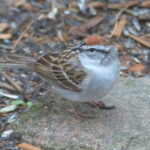
-
Chipping Sparrow
-
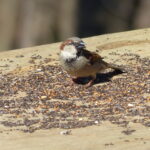
-
House Sparrow
-
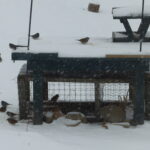
-
Can you find the sparrows?
by Winding Pathways | Mar 2, 2023 | Nature, Travel/Columns
What Do You Need to Know About Winter Travel?
Guest Bloggers, Nancy Sauerman and Bruce Bachmann
I have gone to conferences in the winter but that involves flights, motels, and schedules arranged by someone else. I have had my share of winter travel within the state for short visits or to care for relatives. During our working years, we took our vacations after school semesters ended and before summer class teaching started. After retirement, we still took vacations in the spring or fall — before and after major gardening and food-preserving time and pre/postseason.
Finally, we took a winter travel vacation in January, mainly to visit our sister-in-law, who has Alzheimer’s. We wanted to spend time with her while she still knew us. As longtime campers, we took our basic camping equipment and supplies. After all, we were going south — way south.
What We Learned About Winter Vacations
The days are short. There is less daylight drive time. Driving in the dark in the lethal cold in the middle of nowhere isn’t smart. And so much of the Midwest and Southwest IS the middle of nowhere! Shorter days also mean less time for walking, hiking, and touring. Businesses and museums often have reduced hours. In tourist areas, some restaurants and many campgrounds tend to be closed for the season. Likewise, services such as restrooms and water sources were closed or unavailable (once because of a water pipe break). Roads and trails were blocked. Knowing all this, we didn’t let our gas tank go below half-full. It was too cold to camp.
Where We Did Stay
We stayed at the northern Arkansas farm of our sister and her husband for a couple of nights. While hiking around the farm and learning about their easements to protect the riverbed and banks, old-growth trees, and going through the market gardens, we wore winter coats and wraps. A stiff headwind buffeted us through Oklahoma as we headed to Palo Duro Canyon in the Texas panhandle to camp. Although we have camped down to 30 degrees, with lows predicted to be 24 degrees that night we decided that was pushing it. Also, that state park has the Red River winding back and forth over the road in half a dozen spots. At that temperature, the River would be ice or the roads icy. Dicey! So, we got a motel in Tucumcari, New Mexico. Off-season rates made it more palatable, and it was certainly safer and warmer.
-

-
With over 300 days of sun, chilis dry easily by braiding them into ristras.
-

-
Xeriscaping saves precious water
-

-
The wide horizon reveals brilliant sunrises.
We enjoyed seeing the mountains, including snow-capped ones. Some hikes we took on our way to Las Cruces, NM, included the Valley of Fires lava beds, petroglyphs, and White Sands. All in winter coats. Our brother and his wife hosted us for several days in a comfy setting. Again, we bundled up in winter coats and wraps on our walks, hikes, and trips to the store. Lows at night were in the high teens or low 20s. This was less than an hour from the Mexican border! Winter coats and wraps are cumbersome but better than frostbite. One bonus — no mosquitos, ticks, rattlesnakes, or scorpions! We had only one overcast day and it snowed. So most days we applied sunscreen to our faces; this part of the country has an average of over 325 sunny days per year.
-
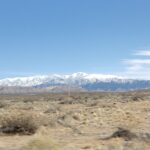
-
Snow-covered peaks
-

-
Traveling the iconic Route 66.
-
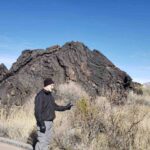
-
Valley of Fires Recreation site in New Mexico
-
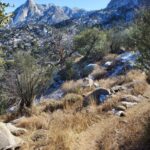
-
Shaped like organs pipes
Wind!
For several days we had high wind warnings. When we finally drove north to Santa Fe, NM, for a few days of culture, history, and adobe architecture, the wind was so strong that we dodged huge tumbleweeds racing across the highway. Whoever was driving would gasp as some, three feet in diameter, even whacked the car. These were not lightweight, stripped-down, bleached tumbleweeds floating across the road. They were full, sturdy balls of Russian thistle whizzing full speed. The wind certainly also cut our gas mileage while we headed west. Our gas mileage was better when we headed back east but the wind wasn’t as strong those days.
Cold Culture
At 7,199 feet above sea level, Santa Fe is the highest elevation state capital. It was cold! One morning we woke to 10 degrees. Needless to say, no camping. The casita where we stayed just a half-mile from downtown had a fully-equipped kitchen, so we were able to cook meals and take breaks between walks to and from the Plaza area with all the museums and historical buildings. Our coats and wraps kept us warm.
-

-
Santa Fe boasts intriguing museums.
-
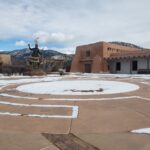
-
Museum of International Folk Art.
-
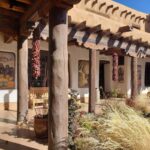
-
Classic architecture.
Keeping an Eye on the Weather
As we readied to head home, weather predictions showed a major winter storm brewing over the Great Plains and ready to plunge into the Upper Midwest. So, winter in America means watching the weather and plotting a safe course of travel, which we did. Staying south and east to avoid serious wind chill warnings, we arrived home a half-hour after the first snow of that storm sifted down. We had expected to have to stay another night in a motel but we slept in our bed that night. Phew!
So, short days, cold, wind, and storms. We will think twice before planning another January Road trip.
by Winding Pathways | Feb 23, 2023 | Mammals, Nature
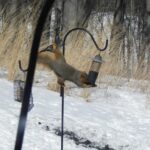
Squirrels are athletic.
Winter squirrels are amusing as they scout out food resources, navigate high wires to cross the road, and forage at local feeders.
Diane and Frank Olsen feed birds, and squirrels, daily and enjoy the antics and dexterity of the neighborhood amusing winter squirrels. Frank noted, “After they raid the bird feeders we have for the juncos, black-capped chickadees, and sparrows, our squirrel friends snarf down the peanuts-in-a-shell that Diane puts out.”
-
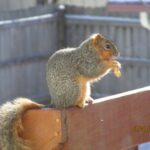
-
The urban squirrels quickly learn who has the best treats. Photo credit Frank Olsen
-
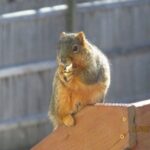
-
This squirrel concentrates on eating while keeping an eye out for predators. Photo credit Frank Olsen
Our cousin to the north has “battled” squirrels for years and watched in awe as a squirrel foiled a winter hawk by jumping into the squirrel trap. The hawk contemplated the situation and then flew off to find easier prey.
Where Are the Squirrels?
We’ve not had much luck foiling squirrels over the years. But, recently we’ve had NO squirrels! They are greedy and do chase off the song birds, but they are fun to watch and usually forage on wild nuts, box elder seeds and other natural delicacies. They also know how to shelter from storms as you see in this summer video.
by Winding Pathways | Feb 9, 2023 | (Sub)Urban Homesteading, Garden/Yard, Nature, Wonderment
“Yes,” to Geese If You Please
Guest blog by Jody Vrieze
When we lived in Plymouth, Iowa, my husband and I realized there is more to a home than just a house. We embraced our love of nature and animals by creating a retreat in our yard featuring natural diversity and beauty. Our outdoor spaces incorporated annual and perennial flowers, bird feeders, chickens, and Sebastopol geese.
Stay-cations vs. Vacations
A backyard pond featured aquatic plants, and different fish like koi, shubunkin, and goldfish. Raised bed gardens and beekeeping gave us additional duties and joy to enhance our little piece of heaven. Every season brought new activities and treasures. We found that we much prefer quiet stay-cations over vacations!
Perhaps the Sebastopol geese were among my favorites. I would call them by simply saying, “Hi peep peeps!”. They’d be running and following me everywhere. Even as I kayaked! Amazing creatures.❤️
Finding Our Inner Geese Love
Their names are Winston, Willow, and Aspen. When you watch the videos, Winston is always in the lead and Aspen is the smooth-feathered goose. At a poultry swap, we dickered with a man over a pair of Sebastopol geese. We walked away and returned. By then the goose had laid an egg. My husband asked if we could buy that egg and the seller replied, “No, but you can have it.”. The man asked if we wanted the pair of geese we’d dickered about to which my husband replied, “Nope, we have an egg!” We bought pizza, and while eating I cradled the egg to keep it warm. We went right out and bought an incubator. After many adventures of incubator lessons – the right temperature, unplugged or not, and against all odds – on Mother’s Day Lucy hatched.
Winston, Lucy, and Aspen
Winston was added to keep Lucy company. After losing Lucy, a lady brought an egg from a gal in Nebraska to add to the “family”. Even more adventures awaited us with geese. One goose broke her leg and I used our koi pond for rehabilitation.
Winston, the goose, tragically lost several mates and lived to be five or so years old before meeting his demise.
Moving On and Planning Ahead
We have since moved and I’m looking forward to a new coop and some new chickens.
After I was asked to share our adventures for the Winding Pathways blogs, I found that I loved going back through the photos and videos and watching the fun we had.
Now in our new location, we recently had a pair of swans and their cygnet land in our field. They came one morning but are gone now. They must have been planning to hunker down for an impending January snowstorm.
-
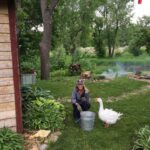
-
What fun to interact with the geese!
-

-
Jody rehabilitated an injured goose in her koi pond.
-
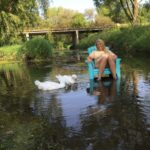
-
The geese flock around Jody in the stream.
by Winding Pathways | Feb 2, 2023 | Foraging, Nature, Pests, Trees, Trees/Shrubs
Disappearing Ash Trees
Ash trees are fast disappearing from American forests and towns. It’s tragic.
There are several ash species, including white, green, blue, and black. A Chinese native insect, the Emerald Ash Borer, is killing them all quickly. It’s awful.
Years ago, Dutch Elm Disease cleared cities of American elms, and many homeowners and towns planted green and white ash trees to replace them. Ashes, in general, thrive in the woods and towns. They grow relatively quickly, resist storm damage, and are beautiful. They seemed like an ideal urban tree.
That was true until Emerald Ash Borers were found in Michigan in 2002, although they may have been around at least a decade earlier. Since then, the insect has spread like crazy, killing ashes radiating outward from Michigan.
They reached Iowa years later and have since killed most of the trees in Cedar Rapids, area woodlands, and many other towns.
Salvaging Ash trees
Rich salvages wood from a scrap pile of used pallets. Pallets are made from cheap wood, like cottonwood, poplar, and hackberry, but now he’s finding ones made of ash.
Loggers are salvaging dead and dying ash trees, and the wood is cheap, at least for now. Soon ash lumber will no longer exist.
A Versatile Wood
Sports fans will miss ash wood. It makes the best baseball bats and has been used for gymnastic bars.
Ash also is crafted into gorgeous furniture.
We lost our big ash tree in the August 2020 derecho, but it was already infested with borers with its days numbered. Sadly, we cut the tree up but gave it a second task. It harvested solar energy and used it to make wood. That wood is now being fed, piece by piece, into our woodstove. It’s keeping our home warm, but we’d rather have our tree.
-

-
Ash bat on oak floor.
-
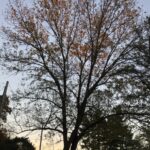
-
The ash tree anchored our east corner of the property.
-

-
White Ash bats will soon be a memory as these elegant trees die.
























